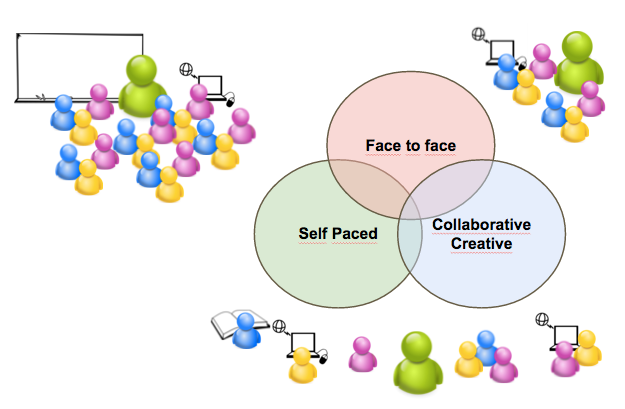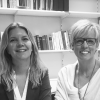Hanna Forsberg, lektor Biologi / Kemi (PhD teacher Biology / Chemistry): It continues to be a debate of should we or should we not include ICT in our teaching. At our school, this is not our debate. Our debate is how can we best use the tools we have to offer students the most effective learning environment. We have come to a conclusion, we need a ‘blended learning environment’.
I use both digital and analog learning activities, and I want to continue. I want my students to read books, brainstorm at the whiteboard, build DNA models and do investigations both in and outside the classroom. However, I understand that it would be very efficient if the instructions, learning results, reflection, feedback, discussions and other details associated with their tasks, is available and can be handled in a digital environment.
By structuring the learning materials on a cloud-based digital platform, I can organise the learning in a way that I could not do otherwise. Students have access to all course material before and after the lesson. It is available wherever they are; on their mobile on the bus, at home, at school or at a library.
Our learning platform opens the class up for interactivity and a variety of modalities that are hard to get to in an analog classroom environment. By mixing, collecting and referring to different types of resources in a learning management system, I can offer students a varied and flexible learning environment. Some students may need more support when we start a new concept, while others need to have more challenge. Some students learn best by reading individually, while others learn best by discussing cases.
With a clear structure, students can see their learning in context. They see the path, and they can see their progress. Students are not stressed by always trying to find the course materials or understand “what is coming next”. If they want to go back and review a topic or move forward to explore an aspect that really interests them, they are empowered to do that. They can better control the tempo of their progress.
With different types of discussion forums and feedback tools, I am able to increase the communication between me and my students, and between students. I can listen to each student, perhaps through an audio recording on the platform's built-in video tool.

Seeing every student explaining replication in separate 45-second videos gives me valuable information about students' knowledge and their understanding of the course concepts. I can also respond with a media recording if I want to. With effective and efficient communication channels I can pursue ongoing formative assessment in (and outside) the classroom. Other tools, such as self-correcting examinations, group chats and peer assessment, are also built into the system. With a clear structure and easily accessible materials, we do not spend as much time in the classroom going through instructions and distributing materials. Digital tools also help to organise groups of students and assess assignments easily and quickly. Feedback to students, via peer feedback or from their teachers, goes faster. Better information about where the students are in their learning make the teaching more cohesive and effective. Our digital feedback system allows reflections and exit tickets to be collected and surveyed easily, which allows me to spend less time on teaching the wrong things.
To develop and implement a BLE
At the start of our BLE project, we have investigated a range of digital platforms on the market, and we are now piloting one in the “free-for-teachers” version.
I am employed as an ICT project coordinator (30% of my position) and my title is instructional designer. The very concept of instructional design can be defined as follows:

We understand there is a need to structure and develop resources and methods to optimise student learning. Educators, researchers, developers, authorities and politicians must work together to create the best possible conditions for learning, and we believe instructional design is a necessary part of this work.
At our school, we are currently working with a core group of four teachers and a shadow group (five people, the growing crowd) to add educational materials and develop secondary courses on our learning management system. This digital structure makes it easy to share courses and learning activities between teachers and schools, which will lighten the preparation workload in many different ways in the future. Instead, we hope to spend more of our time on student contact, peer learning and further pedagogical development.

In a blended learning environment, the class can be divided into different activities. With the clear structure and support the digital platform provides, a part of the class can engage in group work, reading, problem solving, while the teacher has a discussion with the rest of the students. The teacher can easily move between the groups as needed. Teachers have reported that they have more time to communicate with each individual student in this structure. In most courses, it is necessary for students to not only demonstrate an understanding of concepts, but also be able to articulate the connection between them. To be able to move around the room to listen to each student share and discuss is invaluable.
Benefits: How many is too many?
The issue of group size is no longer about "big or small classes", but rather how we can adjust the group size (and staffing ratio) for the learning activity. Reading and lecture can work in larger groups, while discussions and team problem solving is much more successful in small groups.
Benefits: Reduced administration ...
If we could use less time on the administration of a class, then we could focus on what is really important - the students. Of course, more time to plan meaningful lessons and communicate with students for feedback and formative assessment is optimal.
Benefits: More "face-time" with the students ...
All in all, the use of ICT in teaching allows us to have more time for dialogue and direct contact with students exactly when and where they need it.

Kristy: As a school leader, I have decided to stop looking for the “perfect” learning environment. Instead, I am focused on how can I support my teachers to make the best instructional decisions. One concrete idea is to build blended learning environments and integrate an instructional designer into every teacher team. I truly believe that teachers are the key to our students success. And, this is how we can #unleashpotential!
Do you use blended learning in your school? Let us know in the comments!


















